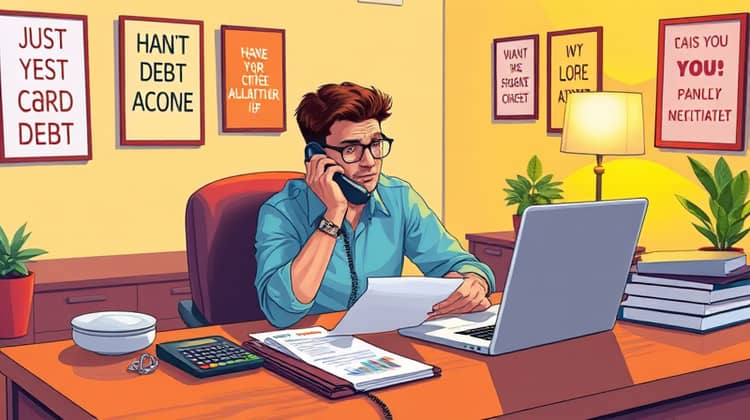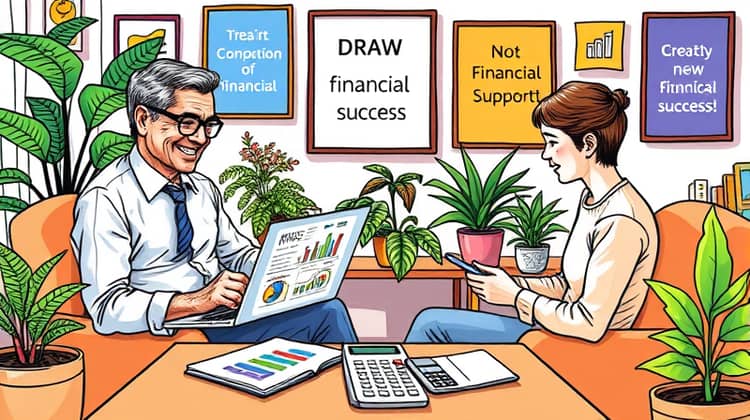Credit card debt is a common financial struggle many people face today. It can create stress and restrict your financial freedom, making it crucial to develop a robust strategy for paying it off effectively. In this article, we will explore various approaches and techniques to help you tackle your credit card debt head-on, ensuring a clearer path towards financial stability.
Firstly, acknowledging your debt and understanding the implications of high-interest rates is essential. Credit cards can quickly spiral out of control, causing anxiety and unexpected financial burdens. By employing effective strategies, you can gain control over your situation, reduce your overall debt, and work towards a debt-free life.
Let's dive into these strategies that will not only help reduce your debt but also empower you to make informed financial decisions moving forward.
1. Create a Debt Repayment Plan

Creating a debt repayment plan is essential for successfully managing credit card debt. It allows you to view your financial situation in a structured manner and prioritize your payments. A well-thought-out plan will not only keep you organized but can also provide clarity and motivation as you take important steps towards freeing yourself from debt.
When designing your plan, start by listing all credit card debts along with their minimum payments and interest rates. This will give you a comprehensive picture of your debts and help you identify which debts are costing you the most.
Next, choose a repayment method that works best for you, whether it's the Debt Snowball or Debt Avalanche method. Both approaches have their merits, and the right choice depends on your personal circumstances and preferences.
- List all your credit card debts
- Choose a repayment strategy
- Set a monthly payment goal
a. Debt Snowball Method
The Debt Snowball Method is a popular strategy advocated by many financial experts for its psychological benefits. This method involves paying off your smallest debt first, regardless of the interest rate. Once the smallest debt is paid off, you move on to the next smallest debt, creating a momentum that can keep you motivated to continue paying off all your debts.
One major advantage of the Debt Snowball Method is that paying off smaller debts can provide quick wins. These quick victories can give you a sense of accomplishment and motivate you to tackle larger debts. Furthermore, it can help build the habit of making consistent payments, which is foundational for financial health.
Ultimately, while this method may not always be the most economical in terms of interest paid, it can be effective for individuals who struggle with motivation and need psychological boosts along their debt repayment journey.
- Focus on your smallest debt first
- Use any extra funds to pay off that debt
- Once paid off, tackle the next smallest debt
Committed to the Debt Snowball Method can provide the psychological boost you need, making it easier to approach your larger debts with newfound confidence.
b. Debt Avalanche Method
In contrast to the Debt Snowball Method, the Debt Avalanche Method prioritizes debts based on interest rates. This means you pay off the debt with the highest interest rate first while making minimum payments on all other debts. This approach can save you money on interest payments in the long run, making it a financially savvy choice.
This method requires patience, as it may take longer to pay off your first debt, especially if that debt has a considerable balance. However, over time, this method can result in better long-term financial health since it minimizes the amount of interest accrued from high-rate debts.
The Debt Avalanche Method is ideal for individuals motivated by saving money and reducing their total debt burden in the quickest time possible. If you prefer a strategy that focuses on minimizing overall costs, this approach may be right for you.
- Identify your debts and their respective interest rates
- Focus on the highest interest rate debt first
- Make minimum payments on all other debts while tackling the highest interest debt
The Debt Avalanche Method may involve more patience initially, but it can lead to significant savings and a quicker resolution of your debt burden.
2. Negotiate with Creditors

Attempting to negotiate with your creditors can be an effective strategy for reducing your credit card debt. Many creditors are willing to work with you, especially if you are experiencing financial difficulties. By advocating for yourself, you may be able to secure lower interest rates, extended payment plans, or even settlements for less than what you owe.
To start negotiating, prepare your financial information and a clear outline of your situation. Make sure to communicate respectfully and assertively with your creditors, explaining your circumstances and the desire to work out a suitable solution.
Additionally, remember to remain firm but polite throughout the process. If one creditor is unwilling to accommodate your requests, do not hesitate to reach out to another, as different organizations may have different policies and flexibility.
- Prepare your financial information
- Communicate respectfully with creditors
- Stay persistent and explore all options
3. Consider Balance Transfer or Debt Consolidation

If you're feeling overwhelmed by multiple credit card debts, you may want to consider balance transfer credit cards or debt consolidation loans. These options can simplify your debt and potentially lower your interest rates, providing a more manageable repayment process.
A balance transfer allows you to move your existing credit card debt to a new credit card that offers a lower or 0% introductory APR for a limited time. This can be a strategic way to reduce interest costs and pay down debt more quickly, given that you're disciplined about making payments within the promotional period.
On the other hand, debt consolidation loans involve taking out a new loan to pay off your existing debts. This can help you combine multiple debts into one singular, easier-to-manage monthly payment, often at a lower interest rate than the original debts.
a. Balance Transfer Credit Cards
Balance transfer credit cards can be an advantageous method for managing credit card debt. They allow you to transfer high-interest credit card balances to a new card that offers a low or 0% introductory interest rate, typically for a promotional period of 6 to 18 months. This can help you save money on interest while you focus on paying down the debt itself.
However, it's important to read the fine print before committing. Many balance transfer cards come with fees for transferring balances, and the promotional period is limited. Failing to pay off the debt within this time frame could result in high interest that may negate the benefits of transferring the balance.
- Research balance transfer offers
- Consider any transfer fees
- Aim to pay off the balance before the intro period ends
b. Debt Consolidation Loans
Debt consolidation loans are another viable option for tackling credit card debt. With these loans, you borrow money to pay off your existing creditors, effectively consolidating your debts into one loan with a single monthly payment. This can simplify your finances and potentially lower your interest rate, depending on your creditworthiness.
It's crucial to shop around for the best rates and terms when considering a consolidation loan. Additionally, beware of scams or predatory lending practices, as these can lead to more problems down the road. Loan terms and interest rates can vary significantly, so doing your due diligence is essential.
- Determine your total debt amount
- Research various lenders
- Compare interest rates and terms
4. Increase Your Income

Looking for ways to increase your income can be an effective strategy for paying down credit card debt. Whether through side jobs, freelance work, or asking for a raise, additional income can provide the much-needed funds to accelerate debt repayment.
Creating a budget that allows for both essential expenses and dedicated payment amounts towards your debt can help streamline your financial efforts. By dedicating extra income directly to debt payments, you can eliminate debts more quickly and free up future cash flow.
Moreover, investing time in skills development can lead to opportunities for increased salary potential in your current job or new job prospects altogether.
- Consider part-time jobs or side hustles
- Offer skills or services online
- Negotiate for a raise or promotion
5. Cut Unnecessary Expenses

Cutting unnecessary expenses is a vital strategy for freeing up funds to pay down credit card debt. By carefully examining your spending habits and identifying areas where you can reduce costs, you can redirect more money towards your debt repayment efforts.
Start by creating a detailed budget that outlines your income and all expenses, including fixed, variable, and discretionary spending. This awareness can uncover areas where you may be overspending and can make choices to cut back on non-essential items.
- Identify non-essential expenses
- Create a stricter budget
- Resolve to stick with your spending plan
Taking a close look at your expenditures and adjusting your lifestyle can create significant savings that can then be applied to reducing debt efficiently.
6. Seek Professional Help

If managing credit card debt feels daunting or unmanageable, seeking professional help from financial advisors or credit counseling services can be a practical decision. These professionals can provide personalized advice and support tailored to your unique situation, offering expert strategies for debt repayment.
Credit counselors can help you create a budget, negotiate with creditors, and explore debt management plans to reduce monthly payments, making it easier for you to handle your debt responsibly. These services often provide education on personal finance to set you on a successful path moving forward.
Remember that it's essential to research any financial service you consider using, as there are many reputable organizations as well as some that may lead you into further financial trouble.
- Research credit counseling services
- Choose a reputable advisor
- Follow through with the financial plan
Conclusion

Paying off credit card debt can be a challenging task, but with the right strategies and a proactive mindset, it is entirely achievable. Whether you choose to implement a structured repayment plan, negotiate with creditors, or seek professional assistance, the key is to take informed and consistent actions towards your goals.
Remember, financial freedom is within your reach. By incorporating the right techniques, exploring your options, and maintaining a disciplined approach, you can significantly reduce or even eliminate your credit card debt, paving the way for a more secure and empowered financial future.














